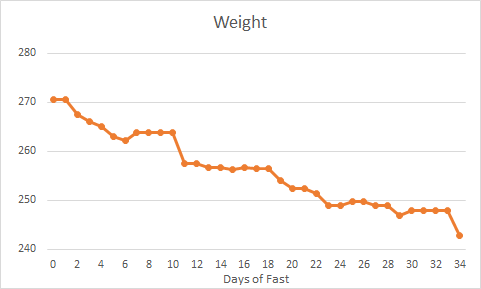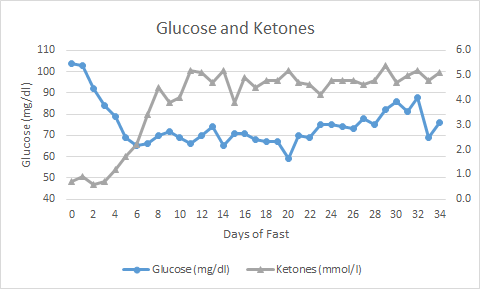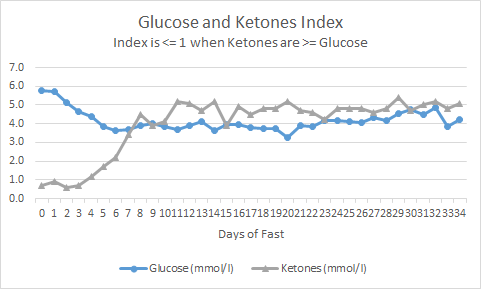Day 34 and 805 hours fasted on water, coffee, bone broth, electrolytes, and occasional heavy cream. Dropped weight nicely fasting on my visit to Tennessee! Here are my numbers for today:



An interesting thing happened in the Nashville airport yesterday: I felt full, satiated, like I couldn’t eat anymore! This is the first time in many, many years that I have felt this way! I have always been able to just eat and eat: my father used to say that cats eat until they’re full but dogs eat until they burst! I always thought of myself as a dog!
So what happened? No, I did not break my fast, I did it with my heavy cream! I had a Starbuck’s venti decaf Americano with heavy cream about 9:30 in the morning. MyFitnessPal rates it at 231 calories or just over ¼ cup of cream. Then I had another at the airport about 3:00 and I couldn’t finish it! I was astonished and pleased that I may not be leptin resistant anymore.
Leptin is the satiety hormone. It tells the brain that we’ve eaten and are not hungry anymore. If not for leptin we would just keep eating and eating. I remember that people would talk about how rich certain desserts, like cheesecake, were and how they could only eat so much of them. I didn’t understand as I could, and did sometimes, go back for a second or third piece. Yesterday I had to stop as I hit that proverbial brick wall and said ‘enough is enough’ before I made myself sick!
So, how do we become leptin resistant? That is a fairly short road as it takes us back to insulin and fructose. Fructose is the sweet part of sugar and, as Dr. Robert Lustig likes to say, is one substance that humans are born to crave.
It seems that our ancestors only had fructose available to them in season, early fall when the fruit ripened. People would go and find the fruit and feast on it as they are addicted to the stuff. The fructose would block leptin from reaching the brain so people ate and ate until they were stuffed with the sweet fruit. Why are we designed this way? Well, fall is the season when we need to fatten up for the winter season where we need to keep warm and store fat for the food sparse season coming. We had to fatten up just like all of the other animals in nature do!
Fructose is not burned for energy like glucose, it is stored as fat by the liver so overindulging in fruit, as we can tend to do, is a natural, and timely, way to fatten us up to survive the cold winter. Today, fruit is available 24/7 in westernized countries and people eat fruit all day long because we are told it is ‘healthy’ for us. Most dietary guidelines say we should consume 3-4 servings a day. Then we wonder why our waistlines are bulging!
Insulin also blocks leptin from getting through to the brain so the brain cannot send out the signal to stop eating. When our blood glucose is high then our pancreas releases insulin to clear the glucose from our bloodstream and this also means that we probably didn’t eat the kind of foods that our body needs because they would not raise the glucose like this. All carbohydrates raise glucose and therefore stimulate an insulin response especially processed carbs! Whole vegetables still break down into glucose but they contain natural fiber which slows the break down and the absorption of sugar.
Processed carbohydrates are very different from whole foods as all of their ingredients have been stripped of any wholesome goodness. Since all of these carbs break down into sugar let’s see how much sugar is there: I have a box of Corn Flakes, a box of Rice Krispies, and a box of Almond Thins out of our pantry.
To calculate total sugar from these foods we need to do a little math but it will be easy I assure you! First find the Total Carbohydrates and subtract the Dietary Fiber (which is less than 1g for 2 of these foods and 0g for the other.) Told you it would be easy! Now, there are 4g carbohydrates to a teaspoon of sugar so divide the net carbs from earlier by 4 to find the number of teaspoons of sugar in a serving.
Corn Flakes: 1 cup (28g) : TC=24g, Fiber=<1g, Net=23g: Sugar = 5.75 teaspoons!
Rice Krispies 1.25 cup (33g) : TC=29g, Fiber=0g, Net=29g: Sugar = 7.25 teaspoons!
Almond Thins 8 pieces (29g) : TC21g, Fiber-<1g, Net=20g: Sugar = 5 teaspoons!
As I said 34 days ago when I started fasting that I was doing this to improve my health and it seems to be working. By keeping my glucose low, which therefore keeps insulin low, it seems to have had a positive affect that leptin is able to do its job once again. A couple of weeks ago, still during the fast, I was able to have 3 cups of coffee with cream with no feeling of fullness but not anymore! A small success in my journey to health and I will try to work better with my body as I learn more about these new signs I am seeing!

 information about a limitation on the amount of calories that can be liberated from adipose tissue (31 kcal per pound of body fat per day). Perhaps the reduction in the consumption of body fat also reduces the toxins that are normally stored there that would trigger a stress response that raise glucose and lowers ketones.
information about a limitation on the amount of calories that can be liberated from adipose tissue (31 kcal per pound of body fat per day). Perhaps the reduction in the consumption of body fat also reduces the toxins that are normally stored there that would trigger a stress response that raise glucose and lowers ketones.



 I was only able to make it to day 33…woohoo! Wow!
I was only able to make it to day 33…woohoo! Wow!